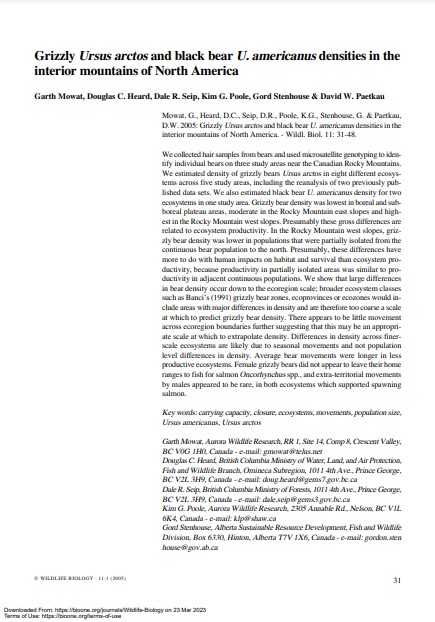Grizzly (Ursus arctos) and Black Bear (U. americanus) Densities in the Interior Mountains of North America
Bosque Modelo:
Foothills
Temática:
Conservación
Tipo de documento:
Artículo científico
Resumen
We collected hair samples from bears and used microsatellite genotyping to identify individual bears on three study areas near the Canadian Rocky Mountains. We estimated density of grizzly bears Ursus arctos in eight different ecosystems across five study areas, including the reanalysis of two previously published data sets. We also estimated black bear U. americanus density for two ecosystems in one study area. Grizzly bear density was lowest in boreal and subboreal plateau areas, moderate in the Rocky Mountain east slopes and highest in the Rocky Mountain west slopes. Presumably these gross differences are related to ecosystem productivity. In the Rocky Mountain west slopes, grizzly bear density was lower in populations that were partially isolated from the continuous bear population to the north. Presumably, these differences have more to do with human impacts on habitat and survival than ecosystem productivity, because productivity in partially isolated areas was similar to productivity in adjacent continuous populations. We show that large differences in bear density occur down to the ecoregion scale; broader ecosystem classes such as Banci’s (1991) grizzly bear zones, ecoprovinces or ecozones would include areas with major differences in density and are therefore too coarse a scale at which to predict grizzly bear density. There appears to be little movement across ecoregion boundaries further suggesting that this may be an appropriate scale at which to extrapolate density. Differences in density across finerscale ecosystems are likely due to seasonal movements and not population level differences in density. Average bear movements were longer in less productive ecosystems. Female grizzly bears did not appear to leave their home ranges to fish for salmon Oncorhynchus spp., and extra-territorial movements by males appeared to be rare, in both ecosystems which supported spawning salmon.
Información Bibliográfica
Autor:
Mowat, G, DC Heard, DR Seip, KG Poole, G Stenhouse and DW Paetkau.
Revista:
Wildlife Biology
Año:
2005
N°:
1
País :
Canadá
Páginas:
31- 48
Volumen:
11
Idioma:
Ingles
Palabras claves
carrying capacity, closure, ecosystems, movements, population size, Ursus americanus, Ursus arctos





